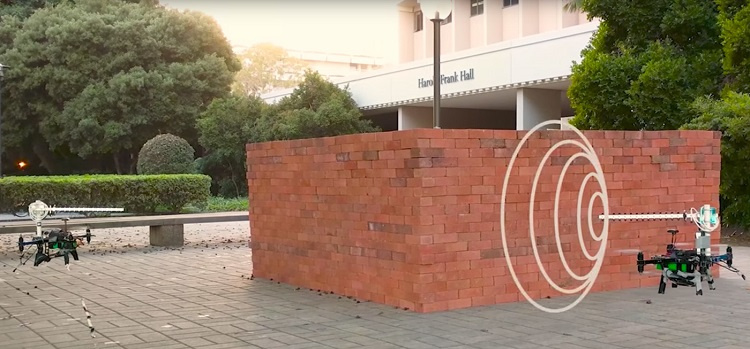The new scheme of Wi-Fi stenovizora allows you to make a 3D model invisible
By itself, the task of seeing through walls has been solved by the military and by rescuers, quite well, for at least 5 years. Military stenovizory even see the breath of the enemy through the wall is not too thick. That is, with the news about observing people through walls or recognizing material objects, few people are surprised by experts. Best and most of all technologies exist, of course, for the needs of law enforcement on the battlefield.
Rescuers and archaeologists have slightly different tasks than controlling a potential enemy - often either thicker or flater obstacles are not enough, and you don’t particularly drag the radar along the rubble and buildings of antiquity. Standing in one place to make a 3D image can only be the most expensive radar. A new solution from the American scientists Yasamin Mostofi and Chitra Karanam will suit the simple task of volumetric scanning of the viscera of closed rooms.

They placed the wi-fi transmitters on the copter drones that fly around the object from opposite sides and wrote a program for processing the received signal power distortions that “see through” the object. The object was a square of brick, inside which were placed two wooden cubes of different sizes - one on the other. A conventional Wi-Fi router with additional antennas was installed on the radiating drone, and the receiving drone was equipped with a Raspberry Pi microcomputer and similar antennas. The program on the tablet tracked the position of the UAVs and controlled their trajectories. See the results in the figure.

During the flight, one drone continuously transmits a WiFi signal, the received power of which is measured by another drone to create a three-dimensional image.
The current development is based on the previous work of the Mostofi laboratory, which was the first to scan objects using common radio frequency signals, such as WiFi. The laboratory published the first experimental demonstration of images using back in 2010. The success of the current 3D experiments is explained by the ability of the copters to approach the area from several angles, as well as in the new proposed methodology.
Potentially, Wi-Fi technology is able to identify a specific person and even draw his portrait. The problem is only in scan time and processing efficiency of the resulting image. Scanning each voxel (volume point) takes too much time. Yasamin and Chitra, in their algorithm, scanned less than 4% of wooden cubes hidden behind a brick wall in order to construct an approximately image. The simplicity of the components used, effective algorithms for calculating the trajectory for flying around objects by drones, and the mathematical model for constructing an image using partial data are considered by the authors to be their main achievement.
Rescuers and archaeologists have slightly different tasks than controlling a potential enemy - often either thicker or flater obstacles are not enough, and you don’t particularly drag the radar along the rubble and buildings of antiquity. Standing in one place to make a 3D image can only be the most expensive radar. A new solution from the American scientists Yasamin Mostofi and Chitra Karanam will suit the simple task of volumetric scanning of the viscera of closed rooms.

They placed the wi-fi transmitters on the copter drones that fly around the object from opposite sides and wrote a program for processing the received signal power distortions that “see through” the object. The object was a square of brick, inside which were placed two wooden cubes of different sizes - one on the other. A conventional Wi-Fi router with additional antennas was installed on the radiating drone, and the receiving drone was equipped with a Raspberry Pi microcomputer and similar antennas. The program on the tablet tracked the position of the UAVs and controlled their trajectories. See the results in the figure.

During the flight, one drone continuously transmits a WiFi signal, the received power of which is measured by another drone to create a three-dimensional image.
The current development is based on the previous work of the Mostofi laboratory, which was the first to scan objects using common radio frequency signals, such as WiFi. The laboratory published the first experimental demonstration of images using back in 2010. The success of the current 3D experiments is explained by the ability of the copters to approach the area from several angles, as well as in the new proposed methodology.
Potentially, Wi-Fi technology is able to identify a specific person and even draw his portrait. The problem is only in scan time and processing efficiency of the resulting image. Scanning each voxel (volume point) takes too much time. Yasamin and Chitra, in their algorithm, scanned less than 4% of wooden cubes hidden behind a brick wall in order to construct an approximately image. The simplicity of the components used, effective algorithms for calculating the trajectory for flying around objects by drones, and the mathematical model for constructing an image using partial data are considered by the authors to be their main achievement.
All Articles